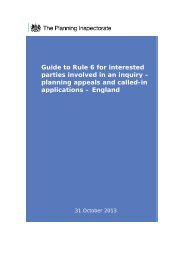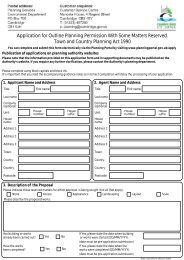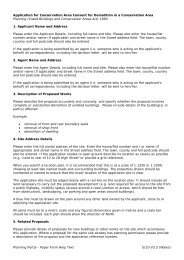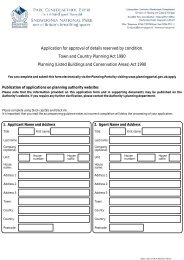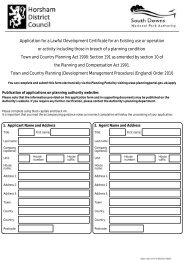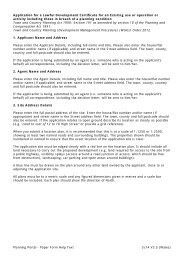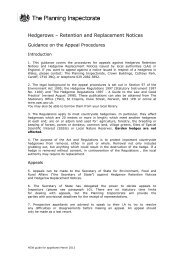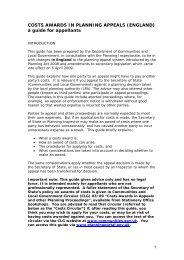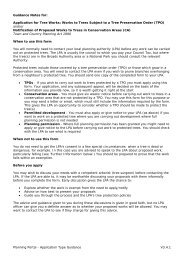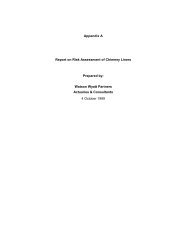Application for Planning Permission and Consent ... - Planning Portal
Application for Planning Permission and Consent ... - Planning Portal
Application for Planning Permission and Consent ... - Planning Portal
You also want an ePaper? Increase the reach of your titles
YUMPU automatically turns print PDFs into web optimized ePapers that Google loves.
<strong>Application</strong> <strong>for</strong> <strong>Planning</strong> <strong>Permission</strong> <strong>and</strong> <strong>Consent</strong> to Display an Advertisement(s)<br />
Town <strong>and</strong> Country <strong>Planning</strong> Act 1990<br />
Town <strong>and</strong> Country <strong>Planning</strong> (Control of Advertisement) Regulations 2007<br />
1. Applicant Name <strong>and</strong> Address<br />
Please enter the Applicant Details, including full name <strong>and</strong> title. Please also enter the house/flat<br />
number <strong>and</strong>/or name (if applicable) <strong>and</strong> street name in the Street address field. The town, county,<br />
country <strong>and</strong> full postcode should also be entered.<br />
If the application is being submitted by an agent (i.e. someone who is acting on the applicant's<br />
behalf) all correspondence, including the decision letter, will be sent to him/her.<br />
2. Agent Name <strong>and</strong> Address<br />
Please enter the Agent Details, including full name <strong>and</strong> title. Please also enter the house/flat number<br />
<strong>and</strong>/or name (if applicable) <strong>and</strong> street name in the Street address field. The town, county, country<br />
<strong>and</strong> full postcode should also be entered.<br />
If the application is being submitted by an agent (i.e. someone who is acting on the applicant's<br />
behalf) all correspondence, including the decision letter, will be sent to him/her.<br />
3. Description of the Proposal<br />
Please describe the proposal accurately <strong>and</strong> concisely. Provide details of all the uses/buildings<br />
proposed.<br />
Example: Detailed application:<br />
• erection of five, two-storey three bed houses<br />
• demolition of existing warehouse <strong>and</strong> redevelopment of the site to provide 25 x two bed flats<br />
in two five-storey blocks with ancillary car parking, open space <strong>and</strong> new access from London<br />
Road<br />
• change of use from office to an A1 Shop<br />
• conversion of a semi-detached house to three self-contained flats<br />
• installation of a new shop front<br />
• industrial development<br />
4. Site Address Details<br />
Please enter the full postal address of the site. Enter the house/flat number <strong>and</strong> / or name (if<br />
appropriate) <strong>and</strong> street name in the Street address field. The town, county <strong>and</strong> full postcode should<br />
also be entered. If the application relates to open ground describe its location as clearly as possible<br />
(e.g. ‘L<strong>and</strong> to rear of 12 to 18 High Street’ or provide a grid reference).<br />
When you submit a location plan, it is recommended that this is at a scale of 1:1250 or 1:2500,<br />
showing at least two named roads <strong>and</strong> surrounding buildings. The properties shown should be<br />
numbered or named to ensure that the exact location of the application site is clear.<br />
The application site must be edged clearly with a red line on the location plan. It should include all<br />
l<strong>and</strong> necessary to carry out the proposed development (e.g. l<strong>and</strong> required <strong>for</strong> access to the site from<br />
a public highway, visibility splays (access around a road junction or access, which should be free<br />
from obstruction), l<strong>and</strong>scaping, car parking <strong>and</strong> open areas around buildings).<br />
A blue line must be drawn on the plan around any other l<strong>and</strong> owned by the applicant, close to or<br />
adjoining the application site.<br />
All plans must be to a metric scale <strong>and</strong> any figured dimensions given in metres <strong>and</strong> a scale bar<br />
should be included. Each plan should show the direction of North.<br />
<strong>Planning</strong> <strong>Portal</strong> - Paper Form Help Text Sc9 V3.6
5. Pre-application advice<br />
The local authority may be able to offer (possibly <strong>for</strong> a fee) pre-application discussions be<strong>for</strong>e a<br />
<strong>for</strong>mal application is submitted in order to guide applicants through the process. This can minimise<br />
delays later in processing the application.<br />
Pre-application discussions can also help you <strong>and</strong> the planning authority identify areas of concern<br />
about your proposed development so that you can give consideration to amending your proposal<br />
be<strong>for</strong>e the application is submitted. The advice <strong>and</strong> guidance given to you at the pre-application<br />
stage is given in good faith. However, it does not guarantee or supply a definitive undertaking as to<br />
whether your proposal is likely to be acceptable.<br />
If you have received pre-application advice from the planning service please indicate the<br />
reference/date of any correspondence or discussion <strong>and</strong> the name of the officer. If you do not know<br />
these details then please state ‘Unknown’.<br />
This will assist the Council in dealing with your application as quickly as possible.<br />
6. Pedestrian <strong>and</strong> Vehicular Access, Roads <strong>and</strong> Right of Way<br />
You must indicate on your <strong>for</strong>m whether you propose any new highway(s) <strong>and</strong> show the location of<br />
these on your plans. Any public highway or footpath that crosses or adjoins the site or is affected<br />
must be shown clearly on the plans, including any proposals that may require a closure or diversion.<br />
Legal procedures <strong>for</strong> diversion or closures must be completed prior to works commencing on site.<br />
Extinguishment of a footpath or bridleway can only be achieved where it can be shown that there is<br />
no longer a need <strong>for</strong> the right of way. In deciding this, an authority must take into account how<br />
much the route is likely to be used by the public be<strong>for</strong>e extinguishment <strong>and</strong> the effect of the<br />
extinguishment on the l<strong>and</strong> over which the route passes.<br />
If you are proposing to undertake any works that will affect the pavement or roadway then it is<br />
advisable to seek advice from the local highways authority.<br />
7. Waste Storage <strong>and</strong> Collection<br />
Please identify what provision has been made <strong>for</strong> the storage of waste <strong>and</strong> recycling as part of the<br />
proposal, <strong>and</strong> demonstrate that these aid the collection of waste <strong>and</strong> recycling materials by the<br />
waste collection authority. The location of waste storage <strong>and</strong> recycling facilities should be clearly<br />
identified on the plans.<br />
8. Council Employee/Member<br />
You must declare whether the applicant or agent is a member of the council’s staff, an elected<br />
member of the Council or related to a member of staff or elected member of the Council.<br />
Serving elected members or planning officers who submit their own planning applications should<br />
play no part in their determination <strong>and</strong> such applications should be determined by the planning<br />
committee rather than by planning officers under delegated powers.<br />
For the purposes of this question, 'related to' means related, by birth or otherwise, closely enough<br />
that a fair-minded <strong>and</strong> in<strong>for</strong>med observer, having considered the facts, would conclude that there<br />
was a real possibility of bias on the part of the decision-maker in the local planning authority.<br />
<strong>Planning</strong> <strong>Portal</strong> - Paper Form Help Text Sc9 V3.6
9. Materials<br />
Please describe the materials you wish to use <strong>for</strong> walls, roofs, etc. including the type, colour <strong>and</strong><br />
name of all materials to be used. You should try to use materials to blend with existing buildings.<br />
Additional in<strong>for</strong>mation may be provided in a design <strong>and</strong> access statement or planning supporting<br />
statement or shown on drawings <strong>and</strong> plans.<br />
If the current site is vacant or is to be demolished then please indicate ‘existing’ materials as being<br />
not applicable.<br />
10. Vehicle Parking<br />
Please specify the total number of existing parking spaces <strong>and</strong> the total number of proposed parking<br />
spaces (including spaces retained) by vehicle type. Please include garage spaces.<br />
If no parking spaces are to be provided you should show on your plans or describe in a supporting<br />
statement where vehicles are to be parked.<br />
The diagram below shows the minimum size of car parking spaces. However, further advice <strong>and</strong><br />
guidance should be sought from your planning authority.<br />
11. Foul Sewage<br />
All new buildings need separate connections to foul <strong>and</strong> storm water sewers. If you propose to<br />
connect to the existing drainage system please show the details of the existing system on the<br />
application drawing(s). Note that in most circumstances surface water is not permitted to be<br />
connected to the public sewers. The use of soakaways will require satisfactory percolation tests to<br />
have been undertaken.<br />
If the proposed development results in any changes/replacement to the existing system or the<br />
creation of a new system, scale plans of the new foul drainage arrangements will need to be<br />
provided. This will include a location plan, cross sections/elevations <strong>and</strong> specifications. Building<br />
Regulations Approval will be required. If connection to any of the above requires crossing l<strong>and</strong> that<br />
is not in the applicant’s ownership, other than on a public highway, then notice may need to be<br />
served on the owners of that l<strong>and</strong>.<br />
<strong>Planning</strong> <strong>Portal</strong> - Paper Form Help Text Sc9 V3.6
12. Assessment of Flood Risk<br />
Owners have the primary responsibility <strong>for</strong> assessing the flood risk to <strong>and</strong> from their property. Sitespecific<br />
Flood Risk Assessments (FRAs) are generally carried out by prospective developers <strong>for</strong><br />
specific development proposals.<br />
Further details are provided in the Technical Guidance to the National <strong>Planning</strong> Policy Framework<br />
Establishing the need <strong>for</strong> a Flood Risk Assessment<br />
The requirement <strong>for</strong> a FRA together with the definitions of flood zones can be found in the Technical<br />
Guidance to the National <strong>Planning</strong> Policy Framework.<br />
The Environment Agency Flood Map which shows the flood zones can be viewed at<br />
www.environment-agency.gov.uk/subjects/flood/lang=_e.<br />
Objectives<br />
The objectives of an FRA are to establish:<br />
• whether the proposed development is likely to be affected by current or future flooding from<br />
any source<br />
• whether it will increase flood risk elsewhere<br />
• whether the measures proposed to deal with these effects <strong>and</strong> risks are appropriate<br />
• whether the development will be safe<br />
Scope<br />
Once it is established whether an FRA is required the scope of the FRA should be agreed with the<br />
Local <strong>Planning</strong> Authority (LPA) <strong>and</strong> Environment Agency (EA) <strong>and</strong> any other relevant bodies. The<br />
FRA should always be proportionate to the degree of flood risk <strong>and</strong> the scale, nature <strong>and</strong> location of<br />
the proposed development. The scoping of the FRA should be done as early as possible in developing<br />
the planning application as avoiding or mitigating flood risk may require important design<br />
considerations which are generally easier <strong>and</strong> more cost-effective to incorporate when developing<br />
the proposal.<br />
Other sources of in<strong>for</strong>mation<br />
Where a Strategic Flood Risk Assessment (SFRA) has been completed by the LPA <strong>and</strong> used to<br />
<strong>for</strong>mulate policy <strong>and</strong> allocate development using the sequential approach in the Local Development<br />
Document (LDD), FRAs should only need to focus on site-specific issues. The LDD policies should<br />
make it clear what issues need to be covered in the FRA. The Environment Agency also has<br />
St<strong>and</strong>ing Advice which can assist in developing the scope, particularly <strong>for</strong> smaller developments, to<br />
be included in a FRA. The St<strong>and</strong>ing Advice is available at:<br />
http://www.environment-agency.gov.uk/planning<br />
Content<br />
Guidance on the content of a FRA is given in the Technical Guidance to the National <strong>Planning</strong> Policy<br />
Framework<br />
https://www.gov.uk/government/publications/national-planning-policy-framework-technicalguidance<br />
https://www.gov.uk/government/publications/national-planning-policy-framework-technicalguidance<br />
https://www.gov.uk/government/publications/national-planning-policy-framework-technicalguidance<br />
<strong>Planning</strong> <strong>Portal</strong> - Paper Form Help Text Sc9 V3.6
13. Biodiversity <strong>and</strong> Geological Conservation<br />
Where a development proposal is likely to significantly affect features of biodiversity or geological<br />
conservation interest, it will be necessary to submit with the application sufficient in<strong>for</strong>mation on<br />
what those effects are, in order <strong>for</strong> the local authority to determine it. The local planning authority<br />
may have produced a list of which features in their area will require such additional in<strong>for</strong>mation. In<br />
some cases this additional in<strong>for</strong>mation may be required based on a survey of affected species,<br />
habitats or geological features <strong>and</strong> an assessment of impacts. What is required will depend on the<br />
significance of the features <strong>and</strong> the scale <strong>and</strong> significance of the likely impacts, <strong>and</strong> what in<strong>for</strong>mation<br />
the local authority already has. It will be advisable to discuss with the local planning authority what<br />
is required, <strong>and</strong> who may be competent to carry out any survey <strong>and</strong> assessment work required,<br />
prior to compiling the in<strong>for</strong>mation <strong>and</strong> submitting the application.<br />
It may be possible to obtain some of the necessary in<strong>for</strong>mation via a search of ecological or<br />
geological data held by a local environmental records centre. <strong>Planning</strong> <strong>for</strong> Biodiversity <strong>and</strong> Geological<br />
Conservation: A Good Practice Guide (referenced below) also provides useful in<strong>for</strong>mation about<br />
other possible sources of biodiversity data <strong>and</strong> ecological surveys.<br />
It is possible that survey in<strong>for</strong>mation can be collected only at certain times of the year <strong>and</strong> the<br />
applicant will need to take this into account in preparing an application <strong>and</strong> considering the timing<br />
<strong>for</strong> the development. Depending on the survey in<strong>for</strong>mation which the local planning authority<br />
requires, the following factors may need to be considered:<br />
• the numbers <strong>and</strong> range of habitats, species of flora <strong>and</strong> fauna <strong>and</strong>/or geological features<br />
found on <strong>and</strong> where appropriate around the site;<br />
• the potential development impacts likely to harm the biodiversity or geological conservation<br />
features identified by the survey (both direct <strong>and</strong> indirect effects both during construction<br />
<strong>and</strong> afterwards). Including how:<br />
o<br />
o<br />
o<br />
o<br />
alternatives designs or locations have been considered<br />
adverse effects will be avoided wherever possible<br />
unavoidable impacts will be mitigated or reduced<br />
impacts that cannot be avoided or mitigated will be compensated<br />
Further in<strong>for</strong>mation on the legislative <strong>and</strong> national planning policy context <strong>for</strong> biodiversity <strong>and</strong><br />
geological conservation can be found in the following documents:<br />
National <strong>Planning</strong> Policy Framework<br />
ODPM Circular 06/2005 Biodiversity <strong>and</strong> Geological Conservation – Statutory Obligations <strong>and</strong> Their<br />
Impact Within The <strong>Planning</strong> System; available at:<br />
https://www.gov.uk/government/policies/making-the-planning-system-work-more-efficiently-<strong>and</strong>effectively/supporting-pages/national-planning-policy-framework<br />
https://www.gov.uk/government/publications/biodiversity-<strong>and</strong>-geological-conservation-circular-06-<br />
2005<br />
<strong>Planning</strong> <strong>for</strong> Biodiversity <strong>and</strong> Geological Conservation: A Good Practice Guide (2006); available at:<br />
https://www.gov.uk/government/publications/planning-<strong>for</strong>-biodiversity-<strong>and</strong>-geologicalconservation-a-guide-to-good-practice<br />
The Institute of Ecology <strong>and</strong> Environmental Management have produced Guidance on Survey<br />
Methodology; available at:<br />
http://www.ieem.net/survey-sources/<br />
This may provide useful in<strong>for</strong>mation on possible survey methods.<br />
<strong>Planning</strong> <strong>Portal</strong> - Paper Form Help Text Sc9 V3.6
14. Existing Use<br />
When describing the current use of the site please also include any details of the part(s) of any<br />
listed building(s)/structure(s) being affected.<br />
When answering whether the site is currently vacant, this means whether the site is currently<br />
not in active use.<br />
Contamination<br />
L<strong>and</strong> affected by contamination covers all cases where the actual or suspected presence of<br />
substances in, on or under the l<strong>and</strong> may cause risks to people, property, human activities or<br />
the environment.<br />
Assessment of contamination of the l<strong>and</strong><br />
The need to provide an adequate assessment of l<strong>and</strong> contamination, <strong>and</strong> advice on minimum<br />
in<strong>for</strong>mation requirements, is outlined in the National <strong>Planning</strong> Policy Framework<br />
https://www.gov.uk/government/policies/making-the-planning-system-work-more-efficiently<strong>and</strong>-effectively/supporting-pages/national-planning-policy-framework<br />
You should also consult your waste planning authority’s website which should make clear what the<br />
statement should contain.<br />
15. Trees <strong>and</strong> Hedges<br />
‘BS 5837: 2012 Trees in relation to design, demolition <strong>and</strong> construction – Recommendations’ offers<br />
advice on how to identify trees on adjacent l<strong>and</strong> that could influence the development.<br />
‘5837: 2012’ also contains detailed guidance on survey in<strong>for</strong>mation <strong>and</strong> plans that should be<br />
provided. Using the methodology set out in the St<strong>and</strong>ard should help to ensure that development is<br />
suitably integrated with trees <strong>and</strong> that potential conflicts are avoided.<br />
PLEASE NOTE this is an application <strong>for</strong> planning permission. It is not an application or notification to<br />
remove or prune protected trees (ie trees which are included in a tree preservation order or located<br />
in a conservation area).<br />
If you are granted full planning permission, you will not need to obtain separate consent <strong>for</strong> tree<br />
works which are required to implement the planning permission. However, works to protected trees<br />
which are not required to implement the planning permission must be the subject of a separate<br />
application or notification using the tree works <strong>for</strong>m.<br />
16. Trade Effluent<br />
Please describe the type, quantities <strong>and</strong> means of disposal of any trade waste or effluent. If<br />
there is to be none please mark as ‘NO’.<br />
<strong>Planning</strong> <strong>Portal</strong> - Paper Form Help Text Sc9 V3.6
17. Residential Units (including Conversion)<br />
Please enter the total number of existing <strong>and</strong> proposed dwellings, that exist at present <strong>and</strong> the<br />
number which would exist after your development, by category <strong>and</strong> dwelling type.<br />
The categories are classified as:<br />
• Market housing – includes properties <strong>for</strong> sale where prices are set in the open market.<br />
• Social rented – includes rented housing owned by local authorities <strong>and</strong> registered social<br />
l<strong>and</strong>lords <strong>for</strong> which guideline target rents are determined through the national rent regime,<br />
set out in the ‘Guide to Social Rent Re<strong>for</strong>ms’ published in March 2001. Also includes rented<br />
housing owned by other persons <strong>and</strong> provided under equivalent rental arrangements to the<br />
above, as agreed with the local authority or funded with grant from the Housing Corporation,<br />
as provided <strong>for</strong> in the Housing Act 2004.<br />
• Intermediate – includes housing at prices or rents above those of social rent but below<br />
market prices or rents. This can include shared equity products (e.g. HomeBuy) <strong>and</strong><br />
intermediate rent (i.e. rents above social-rented level but below market rents). Intermediate<br />
housing differs from low cost market housing (which Government does not consider to be<br />
af<strong>for</strong>dable housing).<br />
• Key worker – includes those groups eligible <strong>for</strong> the Housing Corporation funded Key Worker<br />
Living programme <strong>and</strong> others employed within the public sector (i.e. outside of this<br />
programme) identified by the Regional Housing Board <strong>for</strong> assistance.<br />
The types of dwellings are classified as:<br />
a. Houses - a house is a dwelling that is not a flat <strong>and</strong> includes single storey bungalows.<br />
b. Flats or maisonettes – includes separate <strong>and</strong> self-contained premises constructed or adapted<br />
<strong>for</strong> use <strong>for</strong> residential purposes <strong>and</strong> <strong>for</strong>ming part of a building from some other part of which<br />
it is usually divided horizontally. Maisonettes are flats containing more than one storey.<br />
c. Live-work units - accommodation that is specifically designed to enable both residential <strong>and</strong><br />
business use.<br />
d. Cluster flats/non-self contained - units with no separate or self contained living <strong>and</strong> sleeping<br />
accommodation within a larger building of which it <strong>for</strong>ms a part.<br />
e. Sheltered housing - specifically designed housing in a group with services such as the support<br />
of a warden, communal facilities, alarm systems <strong>and</strong> laundry services. Also includes grouped<br />
housing schemes without the services of a warden <strong>and</strong> other communal facilities.<br />
f. Bedsits/studios – refers to a bedroom/living room containing cooking facilities. In addition, it<br />
may also contain washing facilities or even a shower.<br />
g. Unknown Type<br />
18. Non-Residential Floorspace<br />
Definitions:<br />
Gross internal floorspace is the internal area of the building, <strong>and</strong> should include circulation <strong>and</strong><br />
service space such as lifts <strong>and</strong> floorspace devoted to corridors, toilets, storage, etc. It does not<br />
include any area external to the building(s).<br />
Where more than one use class is proposed as part of any development, floorspace should be<br />
specified <strong>for</strong> each separate planning unit (by Use Class).<br />
For proposed retail floorspace (Use Class A1) the amount of tradeable floor area of the total gross<br />
internal floorspace should also be provided. Tradeable floorspace is sales space which customers<br />
have access to (excluding areas such as storage).<br />
For outline applications, please enter the maximum floorspace <strong>for</strong> each use <strong>for</strong> which you are<br />
applying.<br />
All floorspace figures should be provided in square metres.<br />
<strong>Planning</strong> <strong>Portal</strong> - Paper Form Help Text Sc9 V3.6
19. Employment<br />
Please give details of the total number of existing people (i.e. already employed on the site) <strong>and</strong> any<br />
additional staff to be employed (in both full-time <strong>and</strong> part-time employment) as a result of the<br />
proposal being implemented, <strong>and</strong> calculate the total full-time equivalent posts.<br />
Full-time equivalent numbers can be defined as a statistic representing the number of full-time<br />
employees that could have been engaged if the reported number of hours worked by part-time<br />
employees had been worked by full-time employees. This is usually calculated by dividing the ‘parttime<br />
hours paid’ by the st<strong>and</strong>ard number of hours <strong>for</strong> full-time employees <strong>and</strong> then adding the<br />
resulting quotient to the number of full-time employees.<br />
Proposed employment figures may be particularly relevant when applying <strong>for</strong> town centre <strong>and</strong> retail<br />
development <strong>and</strong> further in<strong>for</strong>mation can be found in the National <strong>Planning</strong> Policy Framework<br />
https://www.gov.uk/government/policies/making-the-planning-system-work-more-efficiently-<strong>and</strong>effectively/supporting-pages/national-planning-policy-framework<br />
20. Hours of Opening<br />
Provide details of the proposed hours of opening <strong>for</strong> each non-residential use proposed on the site.<br />
(In sensitive areas, or where a use could cause nuisance to neighbours, it is likely that the <strong>Planning</strong><br />
Authority would impose a condition restricting the hours of operation on your proposed development<br />
should approval be given.)<br />
In the event that the hours of operation do not match the hours of opening please provide this<br />
in<strong>for</strong>mation in a supporting statement attached to the application.<br />
21. Site Area<br />
The area contained within the boundary of the site to which the application relates will normally be<br />
shown edged in red on the plan accompanying the application, while other l<strong>and</strong> in the same<br />
ownership but not being developed is normally identified separately with a blue line. Site area<br />
should be provided in hectares.<br />
For some application types the fee is based on the site area, in which case an accurate answer to<br />
this question is particularly important.<br />
<strong>Planning</strong> <strong>Portal</strong> - Paper Form Help Text Sc9 V3.6
22. Industrial or Commercial Processes <strong>and</strong> Machinery<br />
• L<strong>and</strong>fill - in all cases this should include void space to be created by mineral extraction.<br />
• Energy from waste incineration - where the incineration of waste will generate electricity,<br />
heat or combined heat <strong>and</strong> power (CHP); where there will be no energy utilisation from<br />
incineration use ‘Other incineration’ box<br />
• Other incineration - where there will be no energy utilisation from the incineration of waste<br />
• Transfer stations - where the main activity will be the bulking up of waste <strong>for</strong> treatment or<br />
disposal elsewhere; may include some sorting, baling, compaction <strong>for</strong> recycling, but where<br />
this is the main activity use material recycling/recovery facilities (MRFs)<br />
• Material recovery / recycling facilities - where the main activity will be the receipt <strong>and</strong><br />
sorting of waste <strong>for</strong> recycling <strong>and</strong> recovery; may include centralised MRFs, community MRFs<br />
<strong>and</strong> as well as small scale recycling bring banks<br />
• Any combined mechanical, biological <strong>and</strong>/or thermal treatment (MBT) - where a<br />
single application proposes a mix of technologies to treat a single waste stream on one site;<br />
where a single technology is proposed use the most specific waste facility type<br />
• Other treatment - where a more specific waste treatment type does not describe the<br />
proposed activity; examples may include separation technologies, vitrification, autoclaving,<br />
etc.<br />
• Storage of waste - where the proposal is <strong>for</strong> medium to long-term storage of waste; where<br />
waste will move to recycling, recovery or disposal in the short-term use Transfer Stations or<br />
MRFs<br />
• Other waste management - including the recovery of waste to l<strong>and</strong> under an exemption<br />
from waste permitting<br />
• Other developments - to include incidental development proposals on existing sites such as<br />
leachate treatment plants <strong>and</strong> weighbridges, where these don’t add waste management<br />
capacity<br />
23. Hazardous Substances<br />
Please give details, including type <strong>and</strong> quantity of hazardous materials to be used or stored on site.<br />
If your application involves the use or storage of hazardous materials above a certain quantity,<br />
Hazardous Substances <strong>Consent</strong> will be required. A list of these materials <strong>and</strong> the permitted<br />
quantities is set out in the <strong>Planning</strong> (Hazardous Substances) Regulations 1992:<br />
http://www.opsi.gov.uk/si/si1992/Uksi_19920656_en_3.htm<br />
24. Type of Proposed Advertisement(s)<br />
Please indicate the number of advertisements proposed by advertisement type: fascia,<br />
projecting, hoarding, etc. If your proposal does not fall within any of the specified<br />
categories, please describe the advertisement(s) in the box provided.<br />
Further in<strong>for</strong>mation on outdoor advertisements <strong>and</strong> signs can be found at:<br />
https://www.gov.uk/government/publications/outdoor-advertisements-<strong>and</strong>-signs-a-guide-<strong>for</strong>advertisers<br />
25. Location of Advertisement(s)<br />
Please confirm if the application is in respect of an advertisement which is already in place. If the<br />
application is in respect of such development please provide details of when the advertisement was<br />
installed.<br />
Please also indicate whether the proposed sign or signs will project over a footpath or other public<br />
highway. This is an important consideration given that any scaffold or hoarding that is erected or<br />
encroaches on the public highway must have a licence obtained from the highways authority.<br />
26. Advertisement(s) Period<br />
The normal period <strong>for</strong> which the planning authority will grant consent is five years, but it may grant<br />
shorter or longer periods at their discretion. However, if you require a sign <strong>for</strong> a shorter temporary<br />
period, please specify the period <strong>for</strong> which consent is sought.<br />
<strong>Planning</strong> <strong>Portal</strong> - Paper Form Help Text Sc9 V3.6
27. Interest in the L<strong>and</strong><br />
It is a condition of every consent granted under the Advertisement Regulations that, be<strong>for</strong>e the<br />
advertisement to which the consent relates is displayed, consent should be obtained from the<br />
owner. Unless you are the owner of the application site permission should be sought from the<br />
freeholder or other individuals entitled to give such permission to erect a sign.<br />
28. Details <strong>for</strong> Proposed Advertisement(s)<br />
Clearly state the type of advertisement proposed (e.g. illuminated fascia sign, non-illuminated<br />
hanging sign, flag, etc.). If more than one advertisement is proposed, describe each individual sign.<br />
Details of advertisements:<br />
a) measure the height from natural ground level to the base of the proposed advertisement in<br />
metres<br />
b) give accurate metric dimensions of each proposed advertisement; if less than one metre in any<br />
dimension, please specify size in millimetres<br />
c) give metric dimensions of the letters, figures or symbols in each of the proposed advertisement<br />
d) give details of all colours proposed<br />
e) please specify the materials of the proposed sign(s)<br />
f) state maximum distance each advertisement projects from the face of the building on which it is<br />
proposed to place the advertisement<br />
g), h) <strong>and</strong> i) where an advertisement is to be illuminated, details of the illumination, illuminance<br />
levels, <strong>and</strong> whether the illumination would be static or intermittent is required<br />
<strong>Planning</strong> <strong>Portal</strong> - Paper Form Help Text Sc9 V3.6
29. Ownership Certificates<br />
An ownership certificate must be completed stating the current ownership of the l<strong>and</strong> to which the<br />
application relates under Article 12 of the Town <strong>and</strong> Country <strong>Planning</strong> (Development Management<br />
Procedure) (Engl<strong>and</strong>) Order 2010.<br />
It is an offence, knowingly or recklessly, to complete a false or misleading certificate.<br />
'Owner' means a person having a freehold interest or a leasehold with at least seven years<br />
unexpired.<br />
'Agricultural tenant' means a tenant of an agricultural holding, any part of which is comprised in the<br />
l<strong>and</strong> to which the application relates.<br />
• Certificate A - Sole Ownership <strong>and</strong> no agricultural tenants<br />
Certificate A should only be completed if the applicant is the sole owner of the l<strong>and</strong> to which the<br />
application relates <strong>and</strong> there are no agricultural tenants.<br />
If the application involves a leasehold flat then certificate A does not apply as the applicant is not<br />
the sole owner. Similarly, Certificate A does not apply if there are agricultural tenants of the l<strong>and</strong> to<br />
which the application relates. There<strong>for</strong>e, in these circumstances, the applicant should complete<br />
certificate B, C or D (see details below).<br />
• Certificate B - Shared Ownership (All other owners/agricultural tenants known)<br />
Certificate B should be completed if the applicant is not the sole owner or if there are agricultural<br />
tenants <strong>and</strong> the applicant knows the names <strong>and</strong> addresses of all the other owners <strong>and</strong>/or<br />
agricultural tenants (e.g. this certificate will need to be served if the proposals encroach onto<br />
adjoining l<strong>and</strong>).<br />
Notice 1 must also be completed <strong>and</strong> sent to all known owners/agricultural tenants.<br />
A copy of the notice should be sent with the application to the local authority.<br />
• Certificate C - Shared Ownership (Some other owners/agricultural tenants known)<br />
Certificate C should be completed if the applicant does not own all of the l<strong>and</strong> to which the<br />
application relates <strong>and</strong> does not know the name <strong>and</strong> address of all of the owners <strong>and</strong>/or agricultural<br />
tenants.<br />
Notice 1 must be completed <strong>and</strong> sent to all known owners <strong>and</strong>/or agricultural tenants.<br />
Where the owners or agricultural tenants are unknown, Notice 2 must be published in a local<br />
newspaper.<br />
A copy of the notice should also be sent with the application to the local authority.<br />
• Certificate D - Shared Ownership (None of the other owners/agricultural tenants<br />
known)<br />
Certificate D should be completed if the applicant does not own all of the l<strong>and</strong> to which the<br />
application relates <strong>and</strong> does not know the names <strong>and</strong> addresses of any of the owners <strong>and</strong>/or<br />
agricultural tenants.<br />
Notice 2 must be published in a local newspaper.<br />
A copy of the notice should be sent with the application to the local authority.<br />
<strong>Planning</strong> <strong>Portal</strong> - Paper Form Help Text Sc9 V3.6
30. <strong>Planning</strong> <strong>Application</strong> Requirements & Local Level Requirements<br />
There are two levels of requirements, national <strong>and</strong> local:<br />
• National - Use the checklist to ensure that the <strong>for</strong>ms have been correctly completed <strong>and</strong> that all<br />
relevant in<strong>for</strong>mation is submitted.<br />
• Local - The local planning authority will have produced a document (usually available from their<br />
website) which details any specific in<strong>for</strong>mation that is required to accompany the application in<br />
addition to the national requirements.<br />
Failure to complete the <strong>for</strong>m correctly or to supply sufficiently detailed drawings or other relevant<br />
supporting in<strong>for</strong>mation may result in your application being returned as invalid.<br />
31. Declaration<br />
Please sign <strong>and</strong> date your application.<br />
32. Applicant Contact Details<br />
Please provide contact in<strong>for</strong>mation <strong>for</strong> the applicant.<br />
33. Agent Contact Details<br />
Please provide contact in<strong>for</strong>mation <strong>for</strong> the agent.<br />
34. Site Visit<br />
Access to the site (i.e. where the works are proposed to take place) may be required by the case<br />
officer. Please provide contact details in the event that an appointment needs to be made. This will<br />
assist the Council in dealing with your application as quickly as possible.<br />
<strong>Planning</strong> <strong>Portal</strong> - Paper Form Help Text Sc9 V3.6





